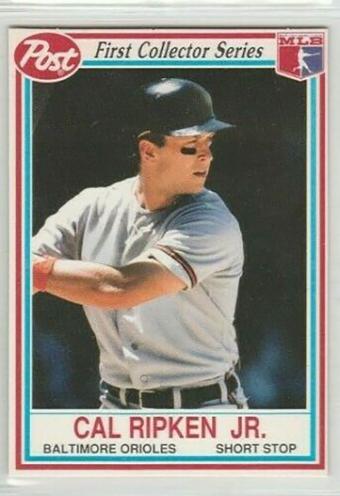
Post Cereal baseball cards were many Baby Boomers' first sports collectibles, printed on the back of cereal boxes rather than requiring separate purchases. Many Boomers are still getting over the shock of finding their beloved childhood items are now on sale in antique stores, and even younger Millennials are reconciling with the fact that their childhood baseball cards are now vintage collectibles. Take a look at the sports cards that helped a famous cereal brand stand out.
Post Cereal Baseball Card Sets: 1960 and 1961
These were sets of baseball cards, including a variety of 200 different cards, all printed on the backs of Post cereal boxes. Because of this, full sets in mint condition are extremely difficult to find, as few kids actually did what parents and teachers always tell them to do: Cut carefully and stay right on the line. Sports memorabilia appraisers usually value these early, complete sets from $1,000 to $3,000, depending on condition. Individual cards usually cost between $15 and $40 for lesser known players, with more renowned heavy hitters' individual cards reaching prices upwards of $2,000.
The 1962 Set
In 1962, Post Cereal released another set of 200 cards. Most of these were printed on cereal boxes, but the Mickey Mantle and Roger Maris cards were instead inserted into the April 13, 1962 Life magazine. (This magazine is itself a collector's item because the cover featured Elizabeth Taylor and Richard Burton, then starring in both Cleopatra and most gossip columns at the time). The prices for cards from this year that are appraised in very good to excellent condition usually end up being in the $25-$50 range, but the Mickey Mantle cards do sell for $100-300, depending on condition, according to collectible price guides.

The 1963 Set
There were 206 cards in Post's 1963 baseball cards series, and because Post put the most popular players on the most popular cereals and the least popular on the least popular cereals, many of the lesser-known players' cards are very hard to find, and thus worth more than those of moderately familiar players.
Some of the most valuable items from Post's 1963 baseball card sets include Mickey Mantle and Carl Yastrzemski, which each can sell for between $400 and $500, respectively. Similarly, cards from popular players and teams that are in valuable condition can fetch anywhere between $15-$100 depending on the seller's market. You can find more about the pricing of all the Post Cereal baseball cards in sports memorabilia price guides.

The 1970s -1990s Sets
After 1963, Post discontinued releasing any more baseball cards until 1979, when the company printed 12 cards on boxes of Raisin Bran cereal. Post didn't put much effort into either producing or marketing these, and the company didn't get back into the collectible baseball cards market until it produced 30-card sets starting in 1990, and continued every year to 1995. Interestingly, this initiative touched on a growing cultural fervor with trading cards that would reach a peak by the late-1990s with cards like Pokemon and Yu-Gi-Oh!
These baseball cards from the first half of the 1990s were the first cards that the company provided in the more traditional three-card cellophane packs that came stored inside the boxes of cereal instead of printed on the boxes themselves. Generally, these cards from the 1990s aren't worth nearly as much as their predecessors, with cards normally selling in individual auctions for about $10-$15.

The 2001 Set
In 2001, Post baseball cards were revived by the breakfast company with the release of 30 new cards, all issued in nine of their popular cereals:
- Alpha Bits
- Marshmallow Alpha Bits
- Golden Crisp
- Honeycomb
- Oreo O's
- Fruity Pebbles
- Cocoa Pebbles
- CinnaCrunch Pebbles
- Waffle Crisp

Like most collectible producers, they aimed these cards at both children and to those who remember the nostalgia of the cards from their own youth. Eighteen of the 30 cards featured contemporary players:
- Moises Alou
- Barry Bonds
- Jermaine Dye
- Tony Gwynn
- Todd Helton
- Orlando Hernandez
- Barry Larkin
- Greg Maddux
- Pedro Martinez
- Mark McGwire
- Mike Piazza
- Manny Ramirez
- Alex Rodriguez
- Ivan Rodriguez
- Gary Sheffield
- Frank Thomas
- Bernie Williams
The other eight cards were all from the Hall of Fame, and were packaged in Raisin Bran, Cinna-Cluster Raisin Bran, and Honey Bunches of Oats cereal boxes:
- Ernie Banks
- Jimmie Foxx
- Reggie Jackson
- Harmon Killebrew
- Willie McCovey
- Frank Robinson
- Babe Ruth
- Mike Schmidt
Unfortunately, if you're looking to sell your childhood collection of these early Millennium cards, don't expect to receive an impressive payout. These cards usually sell for less than $5 a piece, mostly due to their contemporary subjects and lack of a buyer's market.
The 2003 CD-ROM Set
Additionally in 2003, RealNetworks created a series of virtual Post Cereal baseball cards on CD-ROMs and distributed these in selected cereal lines, primarily in the hopes of enticing collectors to subscribe to its Major League Baseball online services. While these are a unique collectible, there hasn't quite been a movement for old tech collectibles like CD-ROMs, meaning that they're something you can find for a few dollars in your local thrift stores or independent online retailers.
Trading Baseball Through the Ages
From cutting out the cards yourself to winning a three-pack prize in your morning cereal, Post's baseball trading cards have been capturing a sense of nostalgia for kids from nearly five decades. Trading cards have waxed and waned in popularity over the years, but early examples have always remained collectible. So, take a look through the top of your grandparent's closet and see if you can find an old binder filled with trading cards from the '60s; you might just earn yourself a nice vacation if you happen to find one of those rare cards tucked away.







